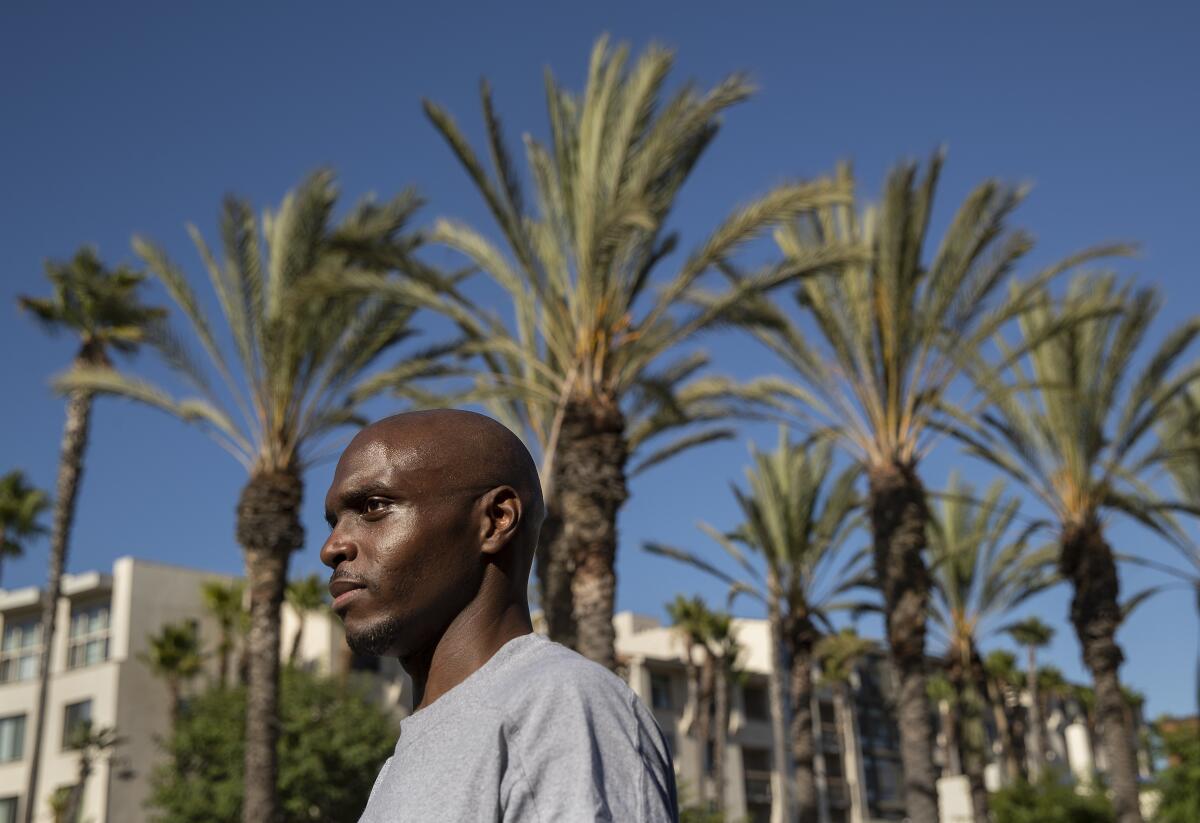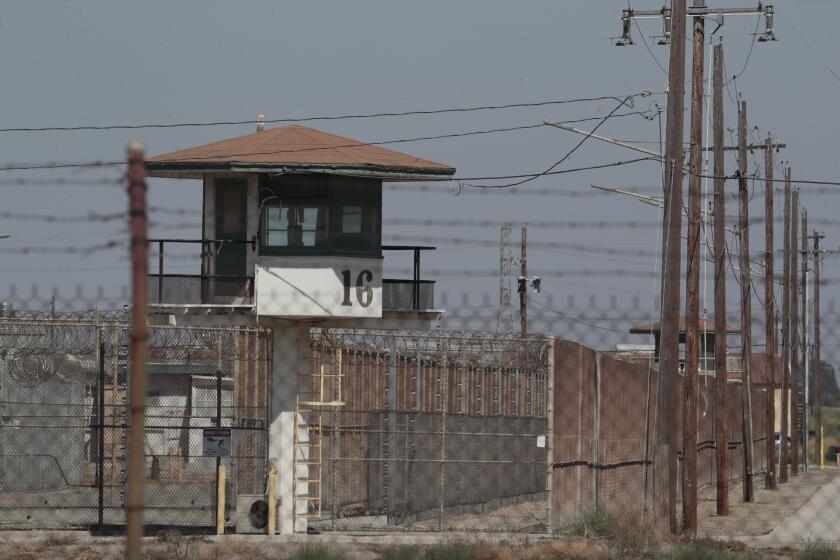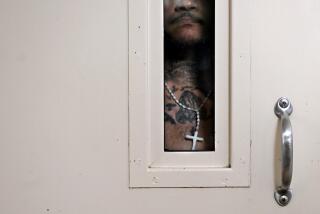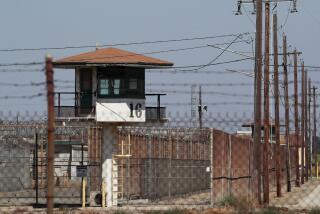Fears grow that releasing thousands of California prisoners will spread COVID-19 into communities

Missteps by corrections officials handling releases from state prisons are fueling fears in some California counties that thousands of inmates eligible for early release will spread the coronavirus in their communities.
Across the state, county probation officials and others on the front lines of the release of as many as 8,000 inmates by the end of August have complained that prisoners were recently freed with little notice to local authorities and without appropriate transportation or quarantine housing â and in some cases, no clear indication they were virus-free.
County officials also have expressed alarm about potentially infected inmates who were released and allowed to ride on public transportation and mingle with the public.
âWe have done everything we can to contain the virus, but they arenât helping,â said Richard Egan, Lassen County administrative officer, referring to corrections officials he contends repeatedly âdumpedâ potentially contagious inmates there before establishing a quarantine regimen.
In a July 20 letter, Barbara Longo, Lassen Countyâs director of health and social services, asked the California Department of Corrections and Rehabilitation to test and isolate inmates for 14 days before releasing them. She cited the case of a recently released inmate, who visited with another freed prisoner while quarantined at a local hotel.
âWe do not know how many times he left his room to go out,â she wrote. âHowever, his 2 test(s) came back positive, 10 days after his release.â
Inmates said they felt helpless as coronavirus swept rapidly through Californiaâs prisons.
Local officialsâ concerns stem in part from the ill-fated transfer in late May of 121 inmates from a coronavirus-ridden prison in Chino to San Quentin, triggering an outbreak there that has killed at least 19 inmates and sickened more than 2,000 others.
Some Chino inmates were cleared for the move based on month-old test results that were useless, leading to a tightening of testing protocols that came too late for many.
At least 47 inmates have been killed by COVID-19 as more than two-thirds of Californiaâs 35 state prisons have been affected. The system had logged 8,039 cases by Thursday, when the count of active infections stood at 1,399.
Earlier this month, Gov. Gavin Newsom announced plans to alleviate the outbreak by releasing as many as 8,000 inmates and further reducing the population by about 10,000 through delayed admissions.
So far, the state has freed 246 inmates listed as âactiveâ COVID-19 cases.
They include Michael Kirkpatrick, 62, who had been deemed suitable for parole and was awaiting final approval when he was released from San Quentin on July 13 and driven to a downtown San Francisco hotel to quarantine with other recently freed inmates.
All were asked to stay put in their single rooms during their isolation, Kirkpatrick said, but few did. Some were out walking around San Francisco while awaiting the results of COVID-19 tests taken the day they were released.
âThe only time you were supposed to come out is when they knocked on your door and brought you food,â he said. âBut you got guys who are just getting out of prison and want their freedom. The person at the front desk is not going to tell you not to go anywhere.â
Kirkpatrick, who has since moved to transitional housing, said he only learned of his test results when he checked in with a parole officer. In the meantime, he said, he received not so much as a temperature check during quarantine, so he and a couple of other former inmates went to a county public health office and got tested.
âNone of us knew anything, and it was bringing up a lot of stress,â he said. âWe didnât know anything and nobody was contacting us.â
All tested negative, he said.
Joe Anderson was released early from the California Institution for Men in April, after serving time for fraud. Anderson, 32, said he left as coronavirus spread âlike a wildfireâ through the Chino prison.
âThey checked my temperature and that was about it,â he said, recalling that he hitched a ride to Sacramento with another inmateâs mother and sister and then got a lift to Mendocino County.
He visited a Dollar Tree and a Wal-Mart before being summoned by the county health department for a coronavirus test, five days after his arrival, he said.
The test came back positive, and Anderson said the probation department immediately asked him in a polite but stern way to take a free room at the local Best Western for 14 days. He was asymptomatic but could have been spreading the disease without knowing it.
âI just wonder how many people they let go like me,â he said.
Corrections officials have not explained the faulty testing at Chino or other specific problems related to early releases, instead pointing to steps theyâve taken to prevent recurrences.
Recently established protocols now require testing to be done no more than seven days before release.
Those who test positive will be isolated and kept in prison until they are no longer contagious, according to the corrections department. An inmateâs case is deemed resolved once at least five days have passed after a fever has gone away without temperature-reducing drugs, and at least 14 days after a positive diagnosis is made.
Corrections officials said that early-release inmates in quarantine status are referred to Project Hope, a voluntary initiative that provides free hotel rooms and food. Those who decline to participate, or do not get special permission to be released to a private residence, will remain in prison for the 14-day period, officials said.
The growing numbers of expedited releases, combined with shutdowns of programs because of the virus, have upended how local authorities deal with newly freed prisoners.
âWe are reinventing how reentry works,â said Alameda County probation chief Wendy Still. âThatâs what we are seeing being built in an ad hoc kind of way.â
Still, whose department is one of the best-funded and most progressive in the state, said that despite early problems, it now has a system in place to quarantine early releases for 14 days in local hotels; those who comply will have the time deducted from the end of their probation period.
Despite âgood intentions by the state,â she said, her department assumes that everyone coming out of prison is potentially positive for the virus because of the intervals between testing and release.
âThere is no guarantee that if you are tested one day, you wonât test positive the next,â Still said.
Her staff must wear full protective gear with every new release, and is largely communicating with those released via phone or internet. Simple tasks, such as picking someone up from prison, have become costly and complicated, with individual probation officers having to sometimes make on-the-fly decisions about safety.
âIt is stressful,â Still said. âTheyâre a peace officer, so they are sworn to protect, but they are human too, so they have concerns not only for themselves but their families.â
Probation departments in particular have been hard hit, since most of those coming out of state prisons are being sent into county supervision. Though the state recently provided $15 million in housing aid, many departments are overtaxed by the sheer volume.
Lonnie Reyman, chief probation officer for Del Norte County in the northwest corner of the state, said his agency has been âforced to scrambleâ as people are released with little notice, and sometimes without housing and services in place.
In small counties like his, there are few nonprofits or outside agencies to assist them, leaving probation departments to handle social service tasks, including finding housing, job placement and now even food deliveries. Reyman is unsure how much of that help his office will be able to provide.
âThat just cuts off at the knees any plans to reintegrate people coming out,â he said.
Reyman said his department has seen about seven releases so far and expects about that many in coming months, which are âhuge numbers for us.â
âThis is a group of people that we would expect to get over the next six to 12 months, and they are all coming out in the next weeks,â Reyman said. âThe plan is changing on a daily basis.â
Karen McDaniel, founder of Fighting for Families Impacted by Incarceration, which offers rides home and other help to those being released, said her organization has been overwhelmed by the need for their services.
Recently, she helped shuttle people from Wasco State Prison in Kern County after the facility released about 60 people over two days. McDaniel said prison officials suggested the men use Amtrak for transportation.
âWhy in the world would you even consider dropping off any amount of formerly incarcerated people at Amtrak right now?â she said. âWhat are you even thinking? I had to mobilize tons of drivers to get out there to get these guys back home because we donât want them on public transportation.â
She said she is frustrated that the corrections department has not provided funding or resources for organizations like hers, which form critical links in the reentry process.
âIt is tremendous pressure,â McDaniel said. âWe shouldnât be the ones completely tasked by the state of California for getting all these releases home. Itâs really quite frankly astounding.â
Corrections officials said inmates released to âquarantine statusâ are not permitted to take public transportation. But some who are not quarantined wonder if they should be.
On Thursday afternoon, Rod Thompson Sr. sat at the Amtrak station in the rural town of Hanford waiting for the 12:24 train to Bakersfield, hours after being released from Avenal State Prison in Kings County.
From there, he planned to take a bus to Los Angeles, and was hopeful he could get in touch with his parole officer before closing time to see if a quarantine hotel was possible.
Though Thompson tested positive for COVID-19 in May, suffering only mild symptoms, he was unsure if he still carried the virus and didnât want to infect others at the shared housing that was his other option.
âI want to self-quarantine again just to be safe,â he said. âI have somewhere to reside ... but I donât feel comfortable going there right now because I donât know if I am contagious.â
More to Read
Sign up for Essential California
The most important California stories and recommendations in your inbox every morning.
You may occasionally receive promotional content from the Los Angeles Times.














